This review was originally published during the 2016 Toronto International Film Festival
On paper, the basic premise of I, Daniel Blake seems a tad drab: a 50-something carpenter struggles to find a job after suffering a heart attack. But thanks to director Ken Loach's deft, dark storytelling, the film is a hyperrealistic, claustrophobic look into the labyrinthine mess that is the British welfare system, using slow-paced, nuanced character building to offer a scathing political statement.
Keeping with Loach's career-long homage to Italian neorealism, the film focuses on Blake's unlikely friendship with struggling single mother Katie following their chance encounter in a Newcastle welfare office. Loach doesn't paint a bad day so much as depict the worst possible day — Murphy's Law is in full force — yet the film never feels trite or heavy-handed thanks to Paul Laverty's script and strong acting from the film's leads.
While Dave Johns' performance as the stubborn, suffering titular protagonist makes for a solid anchor, the film's crowning moments come courtesy of breakout star Hayley Squires as Katie. It's Squires who delivers the film's most heartbreaking moments; while there's perverse hope for Blake as the aging, jobless widower truly has nothing left to lose, Katie's two children — played excellently by newcomers Briana Shann and Dylan McKiernan — are at stake, and her need to provide for them gives the film its tensest moments.
The film is more than just a pity party for those slighted by the labyrinthian process of getting disability benefits: the highs (though few and far between) are triumphant and the lows relatable and tragic. By emphasizing the humanity beneath the issue, the mundane act of running out of time on a library computer turns into a poignant moment in which a glimmer of hope is cruelly yanked away.
I, Daniel Blake succeeds because its protagonists choose to endure and fight against a bureaucratic system that disregards them as little more than statistic data. By showcasing the humanity beneath, Loach turns a series of inconveniences into an epidemic.
(Mongrel Media)On paper, the basic premise of I, Daniel Blake seems a tad drab: a 50-something carpenter struggles to find a job after suffering a heart attack. But thanks to director Ken Loach's deft, dark storytelling, the film is a hyperrealistic, claustrophobic look into the labyrinthine mess that is the British welfare system, using slow-paced, nuanced character building to offer a scathing political statement.
Keeping with Loach's career-long homage to Italian neorealism, the film focuses on Blake's unlikely friendship with struggling single mother Katie following their chance encounter in a Newcastle welfare office. Loach doesn't paint a bad day so much as depict the worst possible day — Murphy's Law is in full force — yet the film never feels trite or heavy-handed thanks to Paul Laverty's script and strong acting from the film's leads.
While Dave Johns' performance as the stubborn, suffering titular protagonist makes for a solid anchor, the film's crowning moments come courtesy of breakout star Hayley Squires as Katie. It's Squires who delivers the film's most heartbreaking moments; while there's perverse hope for Blake as the aging, jobless widower truly has nothing left to lose, Katie's two children — played excellently by newcomers Briana Shann and Dylan McKiernan — are at stake, and her need to provide for them gives the film its tensest moments.
The film is more than just a pity party for those slighted by the labyrinthian process of getting disability benefits: the highs (though few and far between) are triumphant and the lows relatable and tragic. By emphasizing the humanity beneath the issue, the mundane act of running out of time on a library computer turns into a poignant moment in which a glimmer of hope is cruelly yanked away.
I, Daniel Blake succeeds because its protagonists choose to endure and fight against a bureaucratic system that disregards them as little more than statistic data. By showcasing the humanity beneath, Loach turns a series of inconveniences into an epidemic.
